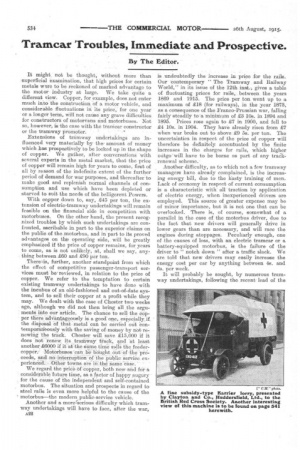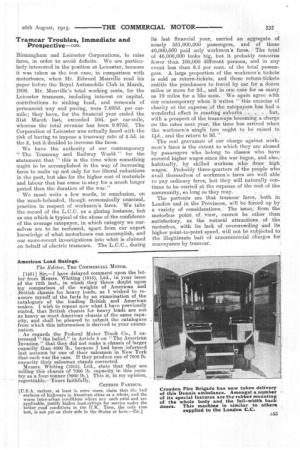Tramcar Troubles, Immediate and Prospective.
Page 4

Page 5

If you've noticed an error in this article please click here to report it so we can fix it.
By The Editor.
It might, not be thought-, without more than superficial examination, that high prices for certain metals were to be reckoned of marked advantage to the motor industry at large. We take quite a different view. Copper, for example, does not enter much into theconstruction of a motor vehicle, and considerable fluctuations in its price, for one year or a longer term, will not cause any grave difficulties for constructors of motorvans and motorbuses. Not so, however, is the case with the tramcar constructor or the tramway promoter.
Extensions of tramway undertakings are in-, fluenced very materially by• the. amount of money which has prospectively to be locked up in the shape of copper. We gather, after conversations with several experts in the metal market, that the price of copper will remain high for years to corne, fiest of all by reason of the indefinite extent of the further period of demand for war purposes, and thereafter to make good and replenish normal channels of consumption and use which have been depleted or starved to suit the needs of the belligerent Powers.
With copper down to, say, 245 per ton, the extension of electric-tramway undertakings will remain feasible on the financial side in competition with motorbuses. On the other hand, the present recognized troubles hy which such undertakings are confronted, ascribable in part to the superior claims on the public of the motorbus, and in part to its proved advantages on the operating side, will be greatly emphasized if the price of copper remains, for years to come, as is not unlikely, at, shall we say, anything between 260 and 290 per ton.
There4.s, further, another standpoint from which the effect of competitive passenger-transport services must be'reviewed, in relation to the price of copper. We refer to the temptation to certain existing tramway undertakings to have done with the incubus of an old-fashioned and out-of-date system, and to sell their copper at a. profit while they may. We dealt with the ease of Chester two weeks ago, although we did not then bring all the arguments into our article. The chance to sell the copper there advantageously is a good one, especially if the disposal of that metal can be carried out contemporaneously with the saving of-money by not renewing the track. Chester will save 215,000 if it does not renew its tramway tie*, and at least another 26000 if it at the same time sells the feeder copper Motorbuses can he bought out of the prdceeds, and no interruption of the public service experienced. Other towns are in the same We regard the price Of copper, both now and for a considerable future time, as a factor of happy augury for the cause of the independent and self-contained motorbus. The situation and prospects in regard to steel rails is even more helpful to the cause of the ' motorbus—the modern public-service vehicle.
Another and a more-serious difficulty which tramway undertakings will have to face, after the war, A22 is undoubtedly the increase in price for the rails. Our contemporary "The Tramway and Railway World," in its issue of the 12th inst., gives a table of fluctuating prices for rails, between the years 1869 and 1915. The price per ton went up to a maximum of 218 (for railways), in the year 1873, as a. consequence of the Franco-Prussian war, falling fairly steadily to .a mininium of 23 10s. in 1894 and 1895. Prices rose again to 17 in 1900, and fell to 24 10s. in 1904. They have already risen from when war broke out to above 29 5s. per ton. The uncertainties in respect of the price of copper will therefore be definitely_ accentuated. by the finite increases in the charges for rails, which higher outgo will have to be borne as part of any trackrenewal scheme.
Another difficulty, as to which not a few tramway managers have already complained, is the increasing energy bill, due to the hasty training of men. Lack of economy in respect of current consumption is a characteristic with all traction by application of electric energy, when inexperienced drivers are employed. This source of greater expense may be of minor importance, but it is not one that can be overlooked. There is, of course, somewhat of a parallel in the case of the motorbus driver, due to the fact that new drivers will generally drive in lower gears than are necessary, and will race the engines during stoppages. Peculiarly enough, one of the causes of loss, with an electric tramcar or a battery-equipped motorbus, is the failure of the driver to " notch down " after a traffic slack. We are told that new drivers may easily increase the energy cost per car by anything between 4s. and 6s. per week.
It will probably be sought, by numerous tramway undertakings, following the recent lead of the Birmingham and Leicester Corporations, to raise fares, in order to avoid deficits. We are particularly interested in the position at Leicester, because it was taken as the test case, in comparison with motorbuses, when Mr. Edward Manville read his paper before the Royal Automobile Club in March, 1906. . Mr. Manville's total working costs, for the Leicester tramcars, including interest on capital, contributions to sinking fund, . and renewals of permanent way andpaving, were 7.695d. per carmile; they have, for the financial year 'ended the 31st March last, exceeded 10d. per car-mile, whereas the total revenue has been 9.875d. The Corporation of Leicester was actually faced with the risk of having to impose a tramway rate of 4.5d. in the I, but it decided to increase the fares.
We have the authority of our contemporary " The Tramway and Railway World " for the statement that " this is the time when something ought to be accomplished in the way of increasing fares to make up not only for too liberal reductions in the past, but also for the higher cost of materials and labour that has come to stay for a much longer period than the duration of the war."
We must write a few words, in conclusion, on the much-belauded, though economically unsound, practice in respect of workmen's fares. We take the record of the L.C.C. as a glaring instance, but as one which is typical of the abuse of the confidence of the average ratepayer, in which category we ourselves are to be reckoned, apart from our expert knowledge of what motorbuses can accomplish, and our more-recent investigations into what is claimed on behalf of electric tramcars. The L.C.C., during its last financial year, carried an aggregate of nearly 551,000,000 passengers, and of these 46,000,000 paid only workmen's fares. The total of 46,000,000 looks big, but it probably concerns fewer than 100,000 different persons, and in any event less than S. per cent. of the total passengers. A large proportion of the workmen's tickets is sold as return-tickets; and these return-tickets entitle the purchasers to travel by car for a dozen miles or more for 2d2, and in one case for as many as 19 miles for a like sum. We again agree with our contemporary when it writes ".this exercise of charity at the expense of the ratepayers has had a wonderful effect in creating suburbs . . but, with a prospeet of the tramways becoming a charge on the rates next Year, the time has arrived when the workmen's single fare ought to be raised t6 lid., and the return to 3.d."
The real gravamen of our charge against workmen's fares is the extent to which they are abused by passengers who belong to classes who have secured higher wages since the war began, and also,habitually, by skilled workers who draw high wages. Probably three-quarters of the people who avail themselves of workmen's fares are well able" to pay ordinary fares, but they, will naturally continue to be carried at the expense of the rest of the community, so long as they may. .
The portents are that tramcar fares, both in London and in the *Provinces, will be forced up by a variety of considerations. The issue," from the' motorbus point of , view, cannot be .other than satisfactory, as the. natural attractions of the motorbus, withits lack of overcrowding and its higher point-to-point speed, *ill not be subjected to the illegitimate bait 'of uncommercial charges for conveyance by tramcar.






















